
West Palm Beach is a city in and the county seat of Palm Beach County, Florida, United States. It is located immediately to the west of the adjacent Palm Beach, which is situated on a barrier island across the Lake Worth Lagoon. The population was 117,415 at the 2020 census. West Palm Beach is a principal city of the Miami metropolitan area, which was home to 6,138,333 people in 2020. It is the oldest incorporated municipality in the South Florida area, incorporated as a city two years before Miami in November 1894. West Palm Beach is located approximately 68 miles (109 km) north of Downtown Miami.
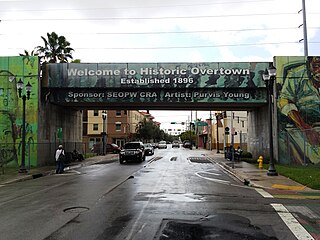
Overtown is a neighborhood of Miami, Florida, United States, just northwest of Downtown Miami. Originally called Colored Town during the Jim Crow era of the late 19th through the mid-20th century, the area was once the preeminent and is the historic center for commerce in the black community in Miami and South Florida.

The Downtown Miami Historic District is a U.S. historic district located in the CBD of Downtown Miami, Florida. The district is bounded by Miami Court, North Third Street, West Third Avenue, and South Second Street. It contains 60 historic buildings. A large portion the buildings in the historic district were built during the Florida land boom of the 1920s, when Miami experienced rapid population growth. Many of the older structures from before the 1920s, were smaller scale buildings and homes from the Miami pioneer era of the mid and late-19th century. Palm Cottage, built in 1897 is a home from the pioneer era that is still standing, however, few of these original homes remain.

Downtown Miami is an urban city center, based around the Central Business District of Miami, Florida, United States. In addition to the central business district, the area also consists of the Brickell Financial District, Historic District, Government Center, Arts & Entertainment District and Park West. The neighborhood is divided by the Miami River and is bordered by Midtown to the north, Biscayne Bay to the east, Civic Center and Overtown to the west, and Coconut Grove to the south.

The Miami City Hospital, Building No. 1 is a historic hospital in Miami, Florida. The historic hospital, which is also known as The Alamo is located at 1611 Northwest 12th Avenue. On December 31, 1979, the building was added to the U.S. National Register of Historic Places. It is known today as Jackson Memorial Hospital.
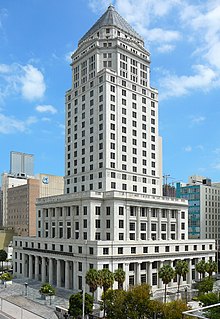
The Miami-Dade County Courthouse, formerly known as the Dade County Courthouse, is a historic courthouse and skyscraper located at 73 West Flagler Street in Miami, Florida. Constructed over four years (1925–28), it was added to the U.S. National Register of Historic Places on January 4, 1989. The building is 361 feet tall with 28 floors. When it was built, it was the tallest building in Miami and in Florida.

The Palm Cottage is a historic home in Miami, Florida. It is the last known building in Miami directly associated with railroad magnate and developer Henry M. Flagler. It is also one of the city's few surviving examples of Folk Victorian architecture. Built around 1897, this house was one of at least 30 rental houses that Flagler constructed as homes for the workers building his Royal Palm Hotel. The building was moved to Fort Dallas Park in 1980, located at 60 Southeast 4th Street. On January 4, 1989, it was added to the U.S. National Register of Historic Places.
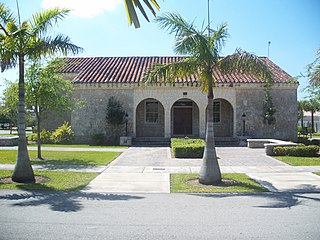
The Lily Lawrence Bow Library is a historic library in Homestead, Florida. It is located 212 Northwest 1st Avenue. On August 5, 1996, it was added to the U.S. National Register of Historic Places. It was named after Lily Lawrence Bow, Homestead's first librarian.

Old Cutler Road is an off-grid plan, 14.9-mile (24.0 km) main northeast–southwest road running south of downtown Miami in Miami-Dade County, Florida, United States.

The First Coconut Grove Schoolhouse is a historic school located within City of Miami limits, in Dade County, Florida. The school originally resided at 2916 Grand Avenue, Miami, Florida, 33133. The structure was built in 1887, by Coconut Grove pioneer, Charles Peacock. Peacock reportedly constructed the house using wood gathered from ships wrecked in nearby Key Biscayne. The building originally served as a community gathering place, with Sunday School as its main purpose.

The Congress Building, or simply the Congress Building, is a historic skyscraper in Downtown Miami, Florida, United States. It is located at the address of 111 Northeast 2nd Avenue. The Congress Building was added to the National Register of Historic Places on March 14, 1985, and is locally identified a historic site in the Downtown Miami Development of Regional Impact (DRI). The Congress Building was formerly office space until 1999, when it was restored and converted to apartments. At street level, the building contains retail space which is leased to a number of stores and services including a financial establishment, The Loft condo sales center, beauty salon and café. Originally the building was five stories; the additional 16 were added on later.
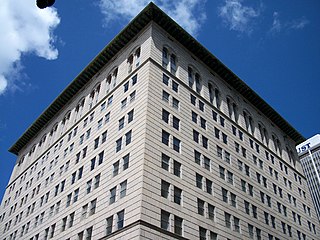
The Ingraham Building is a historic site in Miami, Florida. It is located at 25 Southeast 2nd Avenue. On January 4, 1989, it was added to the U.S. National Register of Historic Places.

The Gesu Church is a historic Roman Catholic church in Miami, Florida. It is located at 118 Northeast 2nd Street. On July 18, 1974, it was added to the U.S. National Register of Historic Places. The church was built in 1896 and is the oldest Catholic Church in Miami.

The Lummus Park Historic District or simply Lummus Park, is on the National Register of Historic Places and a locally historic designated district in Miami, Florida. It is roughly bound by Northwest Fifth Street to the north, Flagler Street to the south, Northwest Third Avenue to the east, and the Miami River to the west. On October 25, 2006, it was added to the U.S. National Register of Historic Places. Lummus Park has some of the oldest structures in Miami, and over the decades, has been able to retain a large part of its early pioneer character.

The Miami-Dade Public Library System (MDPLS) is a system of libraries in Miami-Dade County, Florida, United States.

August Geiger was one of the most prominent American architects in South Florida from 1905 to the late 1940s. He experimented in Mission, Neo-Renaissance and Art Deco architecture, but is most noted for his works in the Mediterranean Revival style. A number of his works are listed on the U.S. National Register of Historic Places.
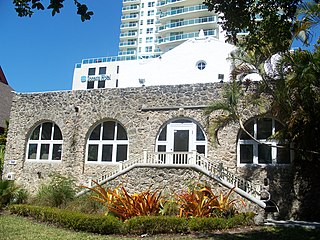
The Woman's Club of Coconut Grove is a historic woman's club in Miami, Florida.

Miami-Dade County is a county located in the southeastern part of the U.S. state of Florida. According to the 2020 census, the county had a population of 2,701,767 making it the most populous county in Florida and the seventh-most populous county in the United States. It is also Florida's third largest county in terms of land area, with 1,946 square miles (5,040 km2). The county seat is Miami, the principal city in South Florida.
The following is a timeline of the history of the city of Miami in Miami-Dade County, Florida, United States.

Miami City Hall is the local government headquarters for the City of Miami, Florida. It has been located in the former Pan American Airlines Terminal Building on Dinner Key, which was designed by Delano & Aldrich and constructed in 1934 for the former International Pan American Airport, since 1954. The city's government headquarters originated in Downtown Miami for 58 years until its relocation to Coconut Grove.























